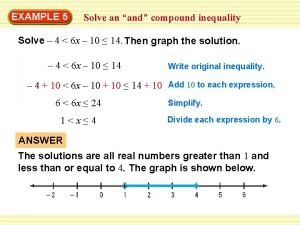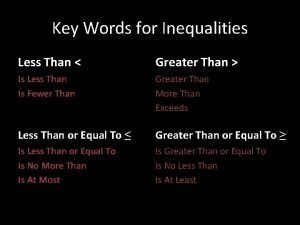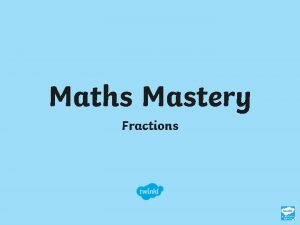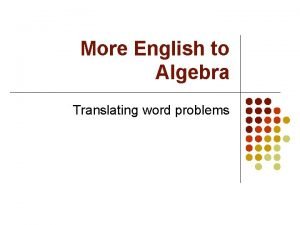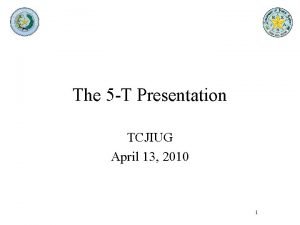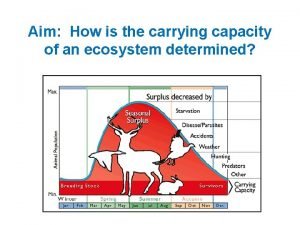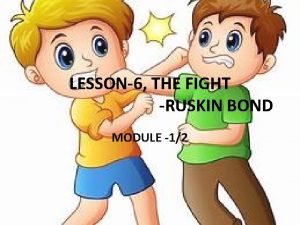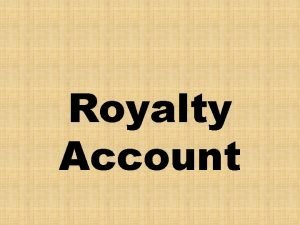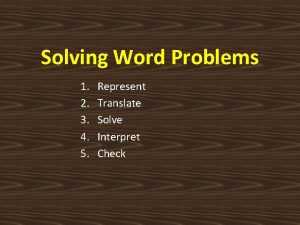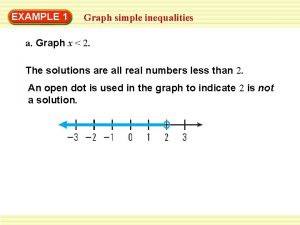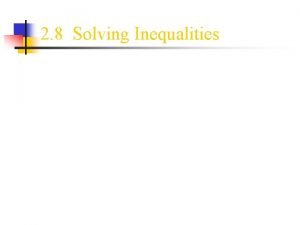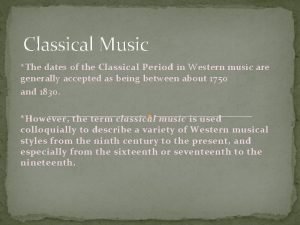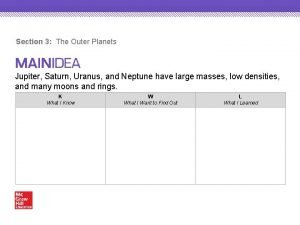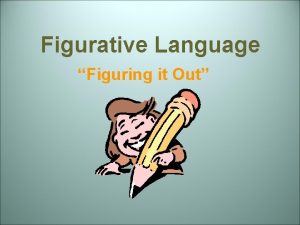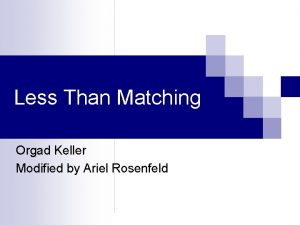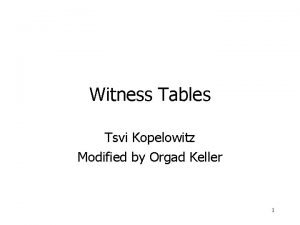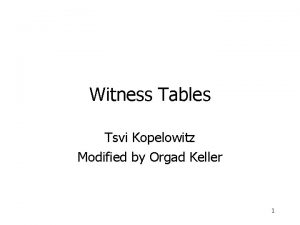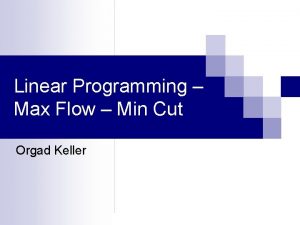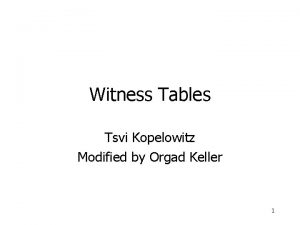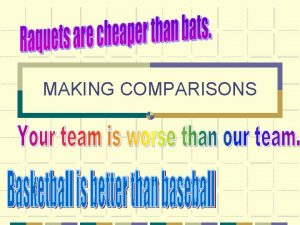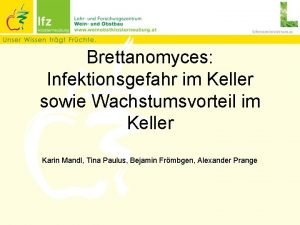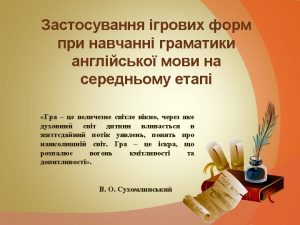Less Than Matching Orgad Keller Less Than Matching























- Slides: 23

Less Than Matching Orgad Keller

Less Than Matching Input: A text , a pattern over alphabet with order relation n Output: All locations where n n . Can we use the regular methods? Orgad Keller - Algorithms 2 - Recitation 12 2

Transitivity n Less Than Matching is in fact transitive, but that is not enough for us: does not imply anything about the relation between and. Orgad Keller - Algorithms 2 - Recitation 12 3

Approach n A good approach for solving Pattern Matching problems is sometimes solving: ¨ The problem for a binary alphabet. ¨ The problem for a bounded alphabet. ¨ The problem for an ubounded alphabet. In that order. Orgad Keller - Algorithms 2 - Recitation 12 4

Binary Alphabet n The only case that prevents a match at location is the case where: n This is equivalent to: n So how can we solve this case? Orgad Keller - Algorithms 2 - Recitation 12 5

Binary Alphabet n So if , there is no match at can calculate ¨ Then we’ll calculate ¨ We’ll return all locations . ¨ We n Time: using FFT. where . Orgad Keller - Algorithms 2 - Recitation 12 6

Bounded Alphabet We need reductions to binary alphabet. n For each we’ll define: n n We notice are binary. Orgad Keller - Algorithms 2 - Recitation 12 7

Bounded Alphabet Theorem: (less than) matches at location if and only if , (less than) matches at location. n Proof: does not match at iff. that is true iff , meaning that does not (less than) match at location. n Orgad Keller - Algorithms 2 - Recitation 12 8

Bounded Alphabet So for each , we’ll run the binary alphabet algorithm on. n We’ll return only the locations that matched in all iterations. n Time: . n Orgad Keller - Algorithms 2 - Recitation 12 9

Unbounded Alphabet Running the bounded alphabet algorithm could result in a time algorithms (We’ll run it only for alphabet symbols which are actually in pattern). n Can be worse than the naïve algorithm. n We present an improvement on the next slides. n Orgad Keller - Algorithms 2 - Recitation 12 10

Abrahamson-Kosaraju Method First, use the segment splitting trick. Therefore we can assume. n For each location in text, we’ll produce a triplet: , where. n For each location in pattern, we’ll produce a triplet: , where. n We now have triplets all together. n Orgad Keller - Algorithms 2 - Recitation 12 11

Abrahamson-Kosaraju Method We’ll hold all triplets together. n Sort all triplets according to symbol. n We’ll define a symbol that has more than triplets as a “frequent symbol”. n There are frequent symbols. n Put all frequent symbols’ triplets aside. n Orgad Keller - Algorithms 2 - Recitation 12 12

Abrahamson-Kosaraju Method n Split non-frequent symbols’ triplets to groups of size in the following manner: Orgad Keller - Algorithms 2 - Recitation 12 13

Abrahamson-Kosaraju Method n The rule is that there can’t be two triplets of the same symbol in different groups. Orgad Keller - Algorithms 2 - Recitation 12 14

Abrahamson-Kosaraju Method For each such group, choose the symbol of the first triplet in group as the group’s representative. n For instance, on previous example, group 1’s representative is and group 2’s representative is. n There are representatives all together. n Orgad Keller - Algorithms 2 - Recitation 12 15

Abrahamson-Kosaraju Method n To sum up: frequent symbols. ¨ representatives of non-frequent symbols. ¨ We’ll swap each non-frequent symbol in pattern and text with its representative. n Now our text and pattern are over sized alphabet. n Orgad Keller - Algorithms 2 - Recitation 12 16

Abrahamson-Kosaraju Method We want to run our algorithm over the new text and pattern to count the mismatches between symbols of different groups. n But we have a problem: n ¨ Let’s say is a frequent symbol, but: Orgad Keller - Algorithms 2 - Recitation 12 17

Abrahamson-Kosaraju Method n The representative of group 2 is , which is smaller than , but the group also contains which is greater than. Orgad Keller - Algorithms 2 - Recitation 12 18

Abrahamson-Kosaraju Method In that case we’ll split group 2 to two groups with their own representatives. n Since we performed at most such splits, we still have representatives. n Orgad Keller - Algorithms 2 - Recitation 12 19

Abrahamson-Kosaraju Method We can now run our algorithm over the new text and pattern in. n But we still haven’t handled comparisons between two non-frequent symbols that are in the same group. n Orgad Keller - Algorithms 2 - Recitation 12 20

Abrahamson-Kosaraju Method n We’ll do so naively in each group: ¨ For n n each triplet in the group For each triplet of the form in the group, if , then add an error at location. Time: Orgad Keller - Algorithms 2 - Recitation 12 21

Running Time n For one segment: ¨ Sorting the triplets and representatives: . ¨ Running the algorithm: . ¨ Correcting results (Adding in-group errors): . Overall for one segment: n Overall for all segments: n Orgad Keller - Algorithms 2 - Recitation 12 . . 22

Running Time n We can improve to ¨ Left . as an exercise. Orgad Keller - Algorithms 2 - Recitation 12 23
 Greek and roman art similarities
Greek and roman art similarities Numberblocks 10
Numberblocks 10 Fractions greater less than or equal to
Fractions greater less than or equal to Compound inequality examples
Compound inequality examples Inequalities key words
Inequalities key words Half life more than 2 less than 4
Half life more than 2 less than 4 Odd one out fractions
Odd one out fractions Percent greater than 100 and less than 1
Percent greater than 100 and less than 1 Translating word problems
Translating word problems Omnixx login texas
Omnixx login texas 7 sum
7 sum Can less than 150 minnows live in this lake
Can less than 150 minnows live in this lake Fdt
Fdt Ranji had been less than a month in
Ranji had been less than a month in Alu control lines
Alu control lines When the royalty are less the minimum rent
When the royalty are less the minimum rent Anglexxx
Anglexxx Graph x is greater than or equal to 3
Graph x is greater than or equal to 3 Prime numbers from 101
Prime numbers from 101 A person who accepts nothing less than excellence is
A person who accepts nothing less than excellence is Is less than open or closed circle
Is less than open or closed circle What are the dates for the classical period in music?
What are the dates for the classical period in music? Uranus was discovered accidentally in 1781
Uranus was discovered accidentally in 1781 The wheat field was a sea of gold
The wheat field was a sea of gold



